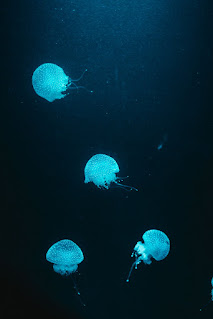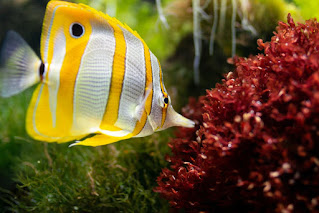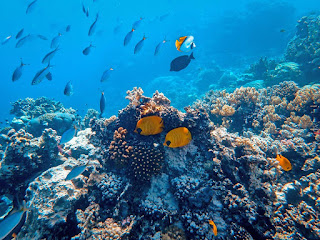Does fish need oxygen
Fish breathe differently from wild animals. Fish have a respiratory system that adapts to the aquatic environment and relies on absorbing oxygen from the water through their gills. Most fish use this mechanism, with the exception of some individual species that absorb oxygen through the skin or breathe through primitive lungs.
Read : can fish drown in water
▪️On the contrary of wild animals, most fish supplies their own oxygen. Instead of using lungs, the fish are using members called gills. Most fish have four pairs of gills present in the cells, on both sides of their heads. The great fish possesses the greases to protect the gills, called "gills cover".
▪️For oxygen, the fish swallows orally water and pays it towards abroad by the gills. For many fish, the process begins when you close the lid and open the mouth. The mouth walls move inside, close the mouth partially and open the lid of the gills. This process causes water flow on the surface of the gills. The inner part of the yetheem reminds us of micro meat. The fiber is close to each other, and is within two loyal rows on the bracket of the gills. Each Lev has many small branches called "Talks", moving water on it. The flowing blood is flowing across the oxygen of water and is launched within the carbon dioxide (yellow balls in the video is poorly red blood cells with oxygen, while the red balls are rich oxygen cells).
The gills
▪️The water comes out via the lid of the gills, and begins the breathing again. There is a clear similarity between the gills and lungs. In both, the body is trying to increase the surface of the respiratory area as far as possible to absorb more oxygen (vesicles are intact in these lungs) and are moving at both small bloodshed, which provides maximum absorption of oxygen Wild animals, atrophy occurred in gills, but it is still possible to see it in these animals, as evolutionary nights on the brackets of the bones of the jaw and ear.
▪️The old fish possess seven braces from the gills, whenever we progress along the evolutionary peace involves the gills and get other functions, such as jaw bones and hearing devices.
What fish can survive without oxygen?
In fact, there aren't any kind of fish or animal can survive without oxygen, but some fishes have others ways to respire. And that what you gonna learn in a few seconds.
Fish breathe
Other ways to breathe fish Not all fish depend on breathing through gills, some get oxygen by absorbing it through the skin, especially young fish, and other animals that live underwater breathe oxygen in the air through the lungs, and they will drown and die if they are unable to reach The surface of the water to obtain oxygen, and after it obtains the necessary oxygen from the surface of the water, it suppresses it just as humans do when diving, and among these organisms are whales and dolphins that are classified among mammals.
How long can fish go without oxygen?
Like humans, fishes also need oxygen at any time when they alive, so fish also can't go for long time without oxygen.
Your lungs take in oxygen from the air when you breathe, so that your cells can use it to provide energy and stay alive. Fish need the same amount of oxygen as humans, and most fish take their oxygen through the water.
Do fish need oxygen in aquarium
Of course, the oxygen dissolves in the water. Fish breathe as water fills their mouths and passes through the gills. The gills absorb oxygen from the water and transport it to the rest of the body.
Here's what happens when most species of fish breathe:
▪️Water flows through the fish's mouth that is open, the fish's mouth shuts off, and the water passes through the gills, which are in recesses on both sides of the head. The gills contain a leaf-like membrane.
Read : how to make a Decorative Aquarium
▪️Blood floats through these platelets, and during this process it absorbs oxygen from the water and produces carbon dioxide. Blood vessels send oxygen to all cells in the fish's body through gill openings on both sides of the head.
This process provides the fish with the necessary oxygen usually, but the fish sometimes come out to the surface of the water and inhale some air, and you may have seen a goldfish do that sometimes.
▪️This indicates that the amount of oxygen in the water is insufficient, the reason for this may be the decomposing food or that the water tank is small, so you should try to change the water in the tank, reduce the amount of food, or increase the size of the tank.
Can fish die from lack of oxygen?
We answered before for : does fish need oxygen, but can fishs die because of lack of oxygen ?
Fish do not die suddenly unless there is a direct cause, such as:
Causes
lack of oxygen, the presence of toxic substances in the basin, or the flow of an electric current in the water, or a sudden rise in temperature to a degree that the fish cannot tolerate, either in natural conditions, the death of fish must be preceded by factors and causes that help On the incidence of diseases, then the final result will be the death of these fish, and these fish may have a disease, but the breeder does not notice this, but thinks that they are normal.
And to find out whether the fish are sick or not, the breeder must observe and observe the behavior of these fish in the pond in terms of eating method, respiratory rates, swimming speed rate, movement rate and fish behavior towards other fish in the pond.
Read : do fish know they are in Water
In short, any abnormality in the fish’s behavior from the normal behavior may be an indication that this fish has a disease.
The following phenomena indicate that the fish in the pond are not well:
1. fish swimming slowly deeply and Turnhaa right and left while swimming.
2. Fish swimming and its fins locked and not open.
3. Significant increase in respiratory rate, as the fish float to the surface and open and close the mouth and operculum at a rapid rate.
4. The rapid, intermittent and circular movement of fish, and this phenomenon is called lightning, which means that the fish makes a sudden swim at a very high speed and hysterically from one place to another.
5. The fish should not try to escape when approaching or trying to stimulate it.
6. Loss of balance in fish.
7. The fish rubs its body against the stones and solid objects in the basin or on the sides of the tank.
8. Fish colors change, especially during the day.
Notice
It should be noted here that some of the changes that occur to the fish may not be the result of these fish being infected with diseases, but rather they are natural changes that occur to the fish at some point, for example if the mating season approaches for some fish, they become more fierce as their colors change very quickly, This is a result of the secretion of certain sex hormones, and here it is necessary to differentiate between the changes that occur due to mating, for example, and those that result from disease.
The oxygen concentration of the fish
The oxygen concentration of the fish's blood reaches 25 times its concentration in the water, and this requires great energy to form it, and the presence of organic pollution in the water increases the energy expended to concentrate and benefit from oxygen, and the lack of blood oxygen increases the speed of blood flow in the gill platelets, which detonates their epithelium exposed to the fatal microbial invasion of the fish.
There is an inverse relationship between flat gills / unit body weight of fish and body weight, and the time required to transport oxygen from the gills to the different parts of the body increases by increasing the size of the fish. The dissolved oxygen decreases, the temperature increases and the breathing volume increases. The utilization of oxygen decreases to 10-20% of the dissolved oxygen in the water passing over the gills.
The ventilation of the gills (the number of times of breathing) increases to cope with the high demand for oxygen with higher temperatures, and the volume of ventilation increases with the decrease in dissolved oxygen. The rate of oxygen consumption remains constant as the dissolved oxygen decreases until the temperature rises, increasing the metabolism of respiration. The rate of utilization of oxygen increases with the temperature.
It must be known that some fish breathe skin, gill, and lungs, that is, gas exchange can occur in the same type of fish in more than one way together.
Organs that help the fish to breathe oxygen
1- Lung:
There are two- lunged fish, Lepidosireniformes, African and South American, developed for living in swamps that are extremely low in oxygen, as they have the ability to use the oxygen of the atmosphere, their gills are relatively short and inactive, and with the drought of the swamps, these fish are able to chop with mucus in a hole in the muddy bottom and lie inside for several months without activity Until the rain falls, even after 4 years.
There are secondary lungfish Dipnoi with one lung, which is spread in Australia and it is the type Neoceratodus fosteri, And it can benefit from the oxygen of the water unless the water is completely stagnant and it is unable to sleep in the summer (cocoon and inactivity), so it spreads in permanent water bodies. Pulmonary fish are more common in warm regions than in cold regions, and more common in tropical swamps.
These fish breathe the atmospheric air voluntarily (despite the abundance of oxygen in the water) or compulsorily (when the swamps dry out or their water is low or naturally, even if water oxygen is provided), the lungs act as basic or secondary respiratory organs.
Although bivalve fish get about 90% of their oxygen through the atmosphere with the help of the lungs, even if the water is well-ventilated, most of the carbon dioxide (60%) is excreted mainly through the gills.
2- Gills:
It is the main respiratory organ in fish, whether bony or cartilaginous, which are of different numbers, and are found under the operculum covering, which are pairs of bony arches covered with muscles that support a double row of red gill strings that form the true respiratory structure of the fish, the branchial arch carries the rays Gill, gill lamellae, which are vascular folds of the mucosa, are arranged on both sides of each branchial septum.
The gill lamellae may be replaced by loose gill filaments hanging from the gill arches. The size, structure and location of the gill cover and gills on the body varies with different types of fish. The gills are the main place for the exchange of gases between the body of fish and water (in the middle of living), as it has a high efficiency in extracting oxygen dissolved in its simple proportion in the water (3% of the oxygen in the air), due to the large area of oxygen on the gills formed by the primary gill plates.
The secondary, rich in blood vessels, in which the blood flows against the direction of the flow of water leaving the gills, due to the efficiency of the gas exchange time.
The water rushes into the mouth and passes through the gills as a result of the exchange of contraction and diastole of the oral cavity and the gills. The oral cavity is first stretched to push the water into it, then the oral cavity contracts with the expansion of the branchial cavity to push the water into the gills and the exchange of gases continues, and the cycle continues continuously. The direction of these movements may be reversed to expel the fish surrounding the gills of impurities and this movement is called fish cough.
The blood flow in the gill platelets is subject to neurohormonal control, in which the body controls the amount of oxygen and the exchange of ions between blood and water. Therefore, breathing may be slow and deep, as in bottom-dwelling fish, in which the gill space is strong and extensible, while in fast-floating fish such as salmon, this base is reversed, i.e. the gill space is small.
The thickness of the frog has a flat gills area of 160 mm 2 / g of thickness while the macrake is 1040 mm 2 / g of thickness, and most bony fish are in the range of 150-350 mm.2 / g.
An increase in the water content of carbon dioxide or lack of oxygen leads to an increase in the volume of renewable water per unit time in bony fish with an increase in the volume of respiration (breathing depth) and its frequency with a decrease in the degree of utilization of oxygen in the breathing water.
As the degree of benefit = (partial pressure of oxygen in the inhaled air - partial pressure of oxygen in the exhaled air) / partial pressure of oxygen in the inhaled air × 100, and the efficiency of the bone fish in utilizing the oxygen content of water is 80% compared to the dog fish whose efficiency is about 50%.
Summary
For conclusion, above there are all informations you need to know about does fish need oxygen, and some tips for aquarium and fish care.











